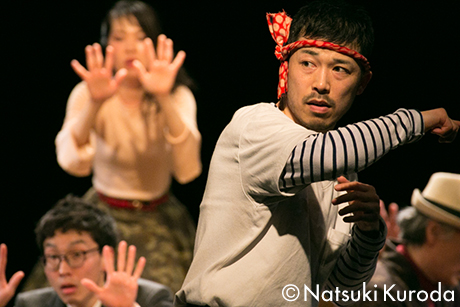

The Japanese, Who Forget
(Apr. 13 – 23, 2017 at KAAT Kanagawa Art Theatre-Medium Studio)
Data
:
Premiere: 2017

The Japanese, Who Forget

Born in 1988, Matsubara is a novelist and playwright. He graduated from the Economics Department of Kobe University. After encountering the works of Samuel Beckett and James Joyce, he began writing novels. He then encountered theater upon seeing theater company Chiten’s production of Fatzer, and subsequently released his own first play titled Michiyuki in 2015. That play won the Grand Prize at the 15th AAF Drama Awards. Matsubara has become known for his unique style characterized by long texts filled with powerful words and a narrative style in which the voices of the characters intermingle and eventually fail to come together into a single coherent storyline. In 2017, Matsubara released Wasureru Nihonjin (The Japanese, Who Forget) in a joint production with Kanagawa Arts Theatre (KAAT) (stage composition by Chiten). With its theme of “oblivion,” the play was highly acclaimed as a statement of poignant critique of Japanese society and the mentality of the Japanese after repeated earthquake disasters, noting their expression of fond attention to the dead. In 2018, Matsubara’s play YAMAYAMA (I Would Prefer Not to) also produced as a collaboration with Chiten and KAAT, was the winner of the 63rd Kishida Drama Award.


The Japanese, Who Forget
(Apr. 13 – 23, 2017 at KAAT Kanagawa Art Theatre-Medium Studio)
Data
:
Premiere: 2017
The center of the stage is cordoned off into a square by a boundary of crude red and white braided ropes, and a wooden ship is placed in the middle of it.
There are seven characters in the script, and all of them except “Michiko” are designated by abbreviations for the names of the actors who appear in the play. Various Japanese appear one after another on stage: a man who looks like a sailor, a woman who looks like a shrine priestess, a man who looks like a regular company employee, a high school girl named Michiko, a man who looks like a pilot, a man who looks like Michiko’s father, and a woman who looks like Michiko’s mother. Their fragmented lines end in the questions “Where?” “Who?” “Why?” and are strangely interrupted with shouts of “Wasshoi,” as they begin what appears the be a voyage with no known destination.
There is no distinctive story, and the characters express their own anxieties, frustrations, and resentments, as the fragmentary images continue to pile up.
In the production directed by Miura, as if to represent “Japanese who forget” in order to avoid confronting reality, the characters basically walk sideways in the sliding-foot style, swaying around with their hands pointing fingers here and there.
Also, as if to represent the communal spirit, when the listeners are facing in the same direction that the speaker points to, a chorus of the chant “Wasshoi” is inserted. Punctuated by these shouts of “Wasshoi, Wasshoi,” the conversation progresses as if by a group carrying a mikoshi (portable shrine carried in the festival).
Related Tags